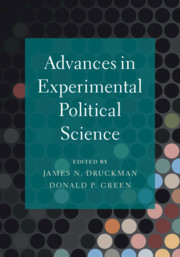Book contents
- Frontmatter
- Contents
- List of Figures
- List of Tables
- List of Boxes
- List of Contributors
- Acknowledgements
- 1 A New Era of Experimental Political Science
- Part I Experimental Designs
- 2 Conjoint Survey Experiments
- 3 Audit Studies in Political Science
- 4 Field Experiments with Survey Outcomes
- 5 How to Tame Lab-in-the-Field Experiments
- 6 Natural Experiments
- 7 Virtual Consent: The Bronze Standard for Experimental Ethics
- Part II Experimental Data
- Part III Experimental Treatments and Measures
- Part IV Experimental Analys is and Presentation
- Part V Experimental Reliability and Generalizability
- Part VI Using Experiments to study Identity
- Part VII Using Experiments to Study Government Actions
- Author Index
- Subject Index
2 - Conjoint Survey Experiments
from Part I - Experimental Designs
Published online by Cambridge University Press: 08 March 2021
- Frontmatter
- Contents
- List of Figures
- List of Tables
- List of Boxes
- List of Contributors
- Acknowledgements
- 1 A New Era of Experimental Political Science
- Part I Experimental Designs
- 2 Conjoint Survey Experiments
- 3 Audit Studies in Political Science
- 4 Field Experiments with Survey Outcomes
- 5 How to Tame Lab-in-the-Field Experiments
- 6 Natural Experiments
- 7 Virtual Consent: The Bronze Standard for Experimental Ethics
- Part II Experimental Data
- Part III Experimental Treatments and Measures
- Part IV Experimental Analys is and Presentation
- Part V Experimental Reliability and Generalizability
- Part VI Using Experiments to study Identity
- Part VII Using Experiments to Study Government Actions
- Author Index
- Subject Index
Summary
Conjoint survey experiments have become a popular method for analyzing multidimensional preferences in political science. If properly implemented, conjoint experiments can obtain reliable measures of multidimensional preferences and estimate causal effects of multiple attributes on hypothetical choices or evaluations. This chapter provides an accessible overview of the methodology for designing, implementing, and analyzing conjoint survey experiments. Specically, we begin by detailing a new substantive example: how do candidate attributes affect the support of American respondents for candidates running against President Trump in 2020? We then discuss the theoretical underpinnings and key advantages of conjoint designs. We next provide guidelines for practitioners in designing and analyzing conjoint survey experiments. We conclude by discussing further design considerations, common conjoint applications, common criticisms, and possible future directions.
Keywords
Information
- Type
- Chapter
- Information
- Advances in Experimental Political Science , pp. 19 - 41Publisher: Cambridge University PressPrint publication year: 2021
Accessibility standard: Unknown
Why this information is here
This section outlines the accessibility features of this content - including support for screen readers, full keyboard navigation and high-contrast display options. This may not be relevant for you.Accessibility Information
- 151
- Cited by
